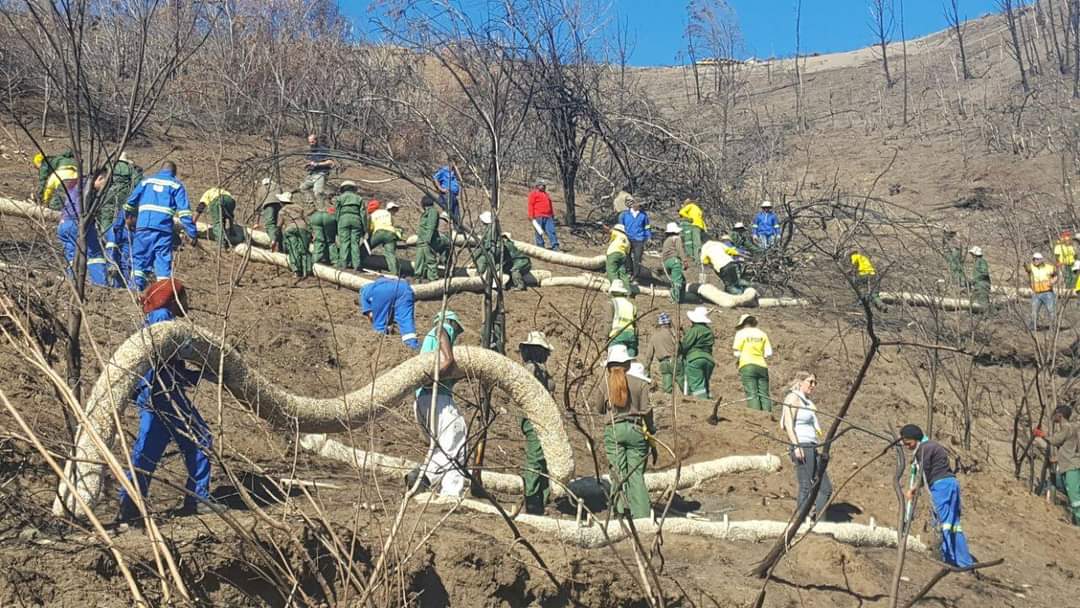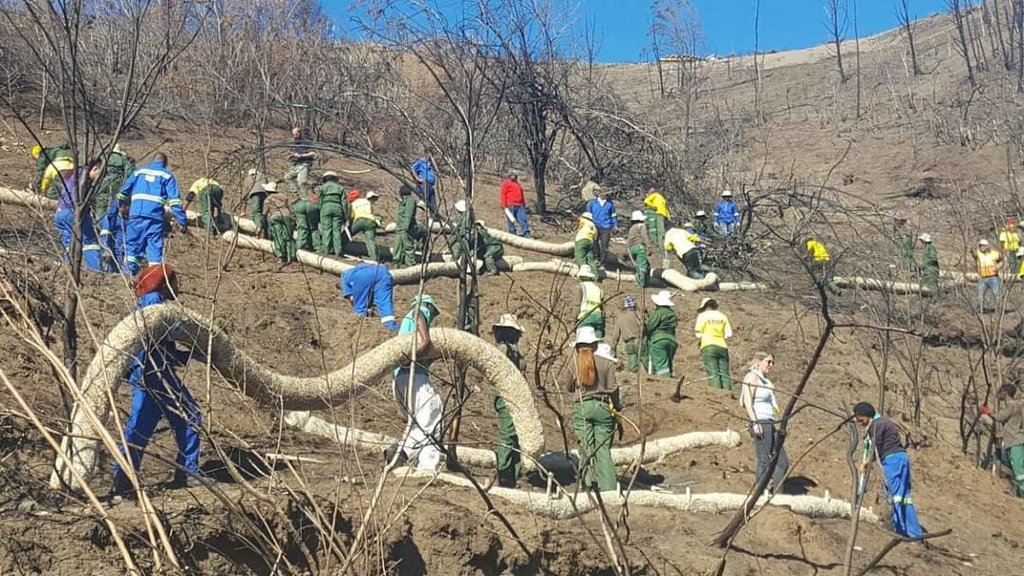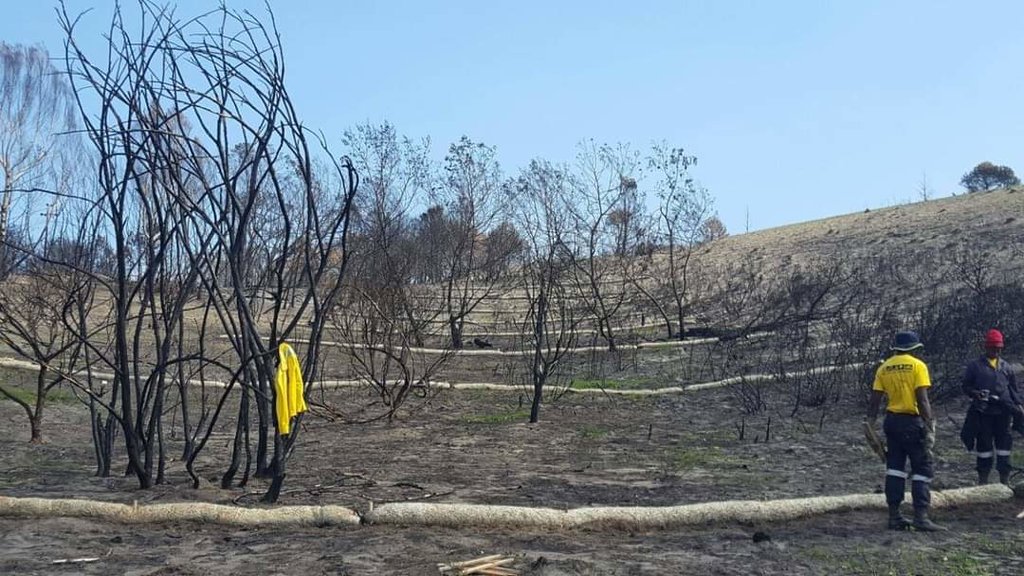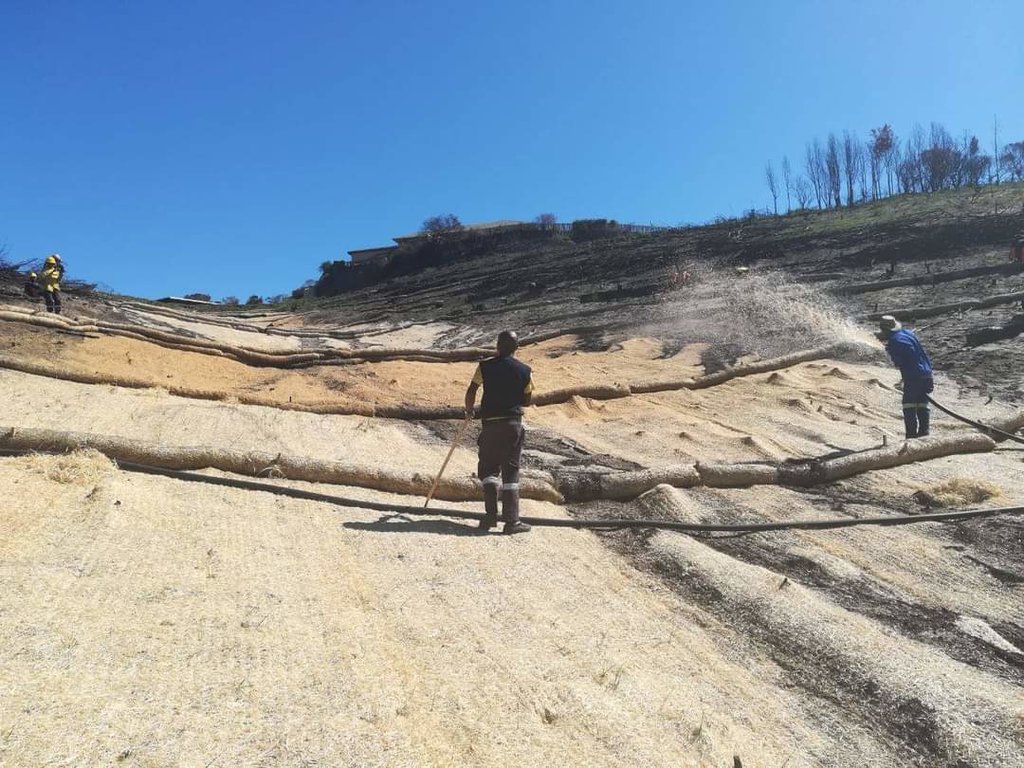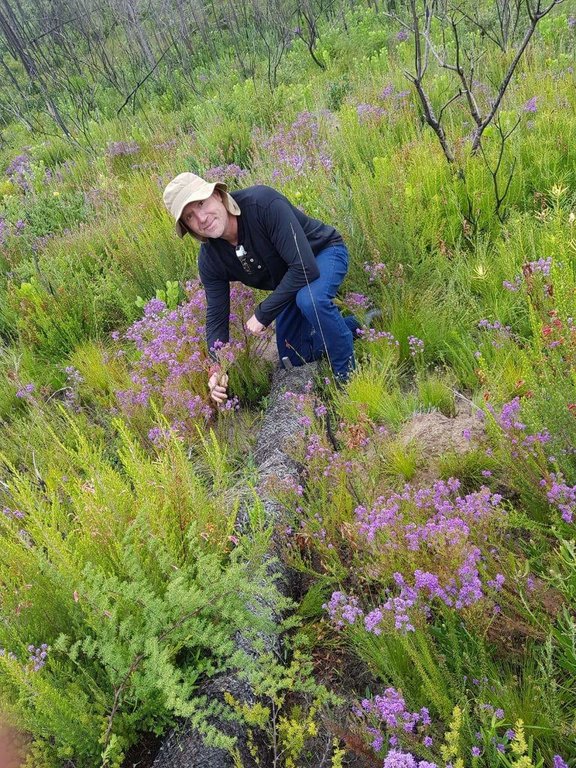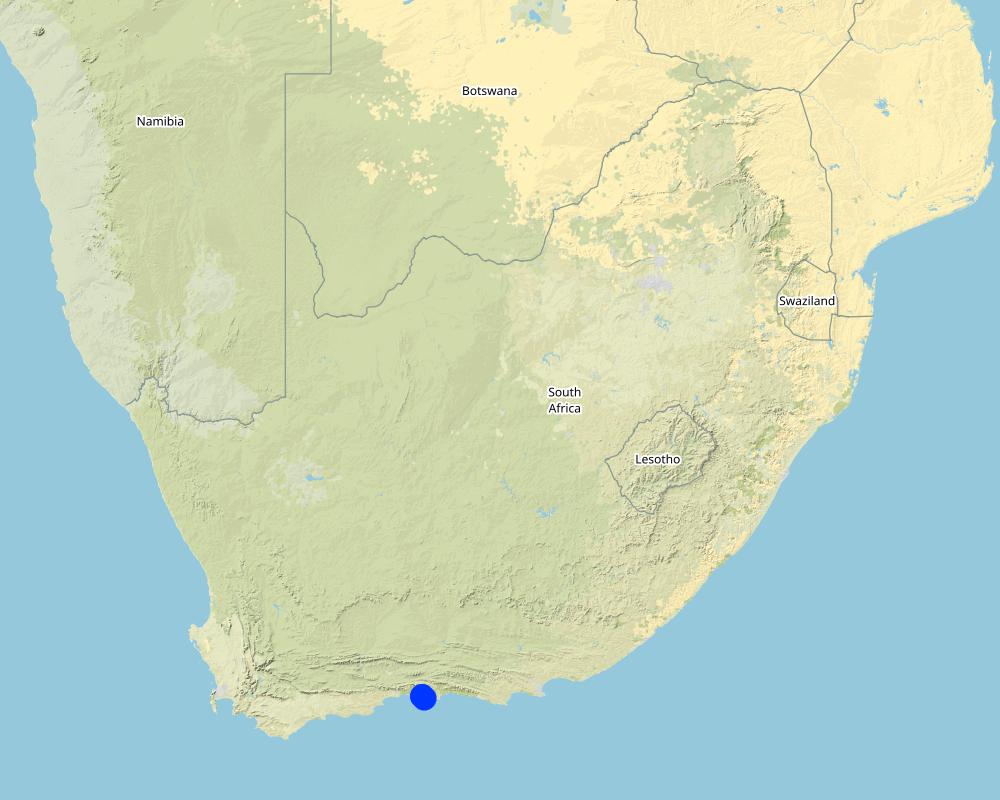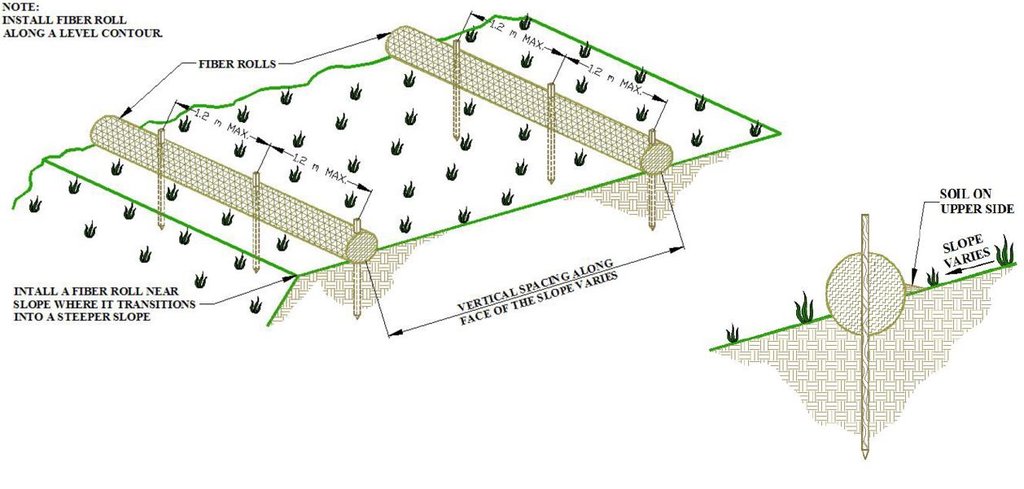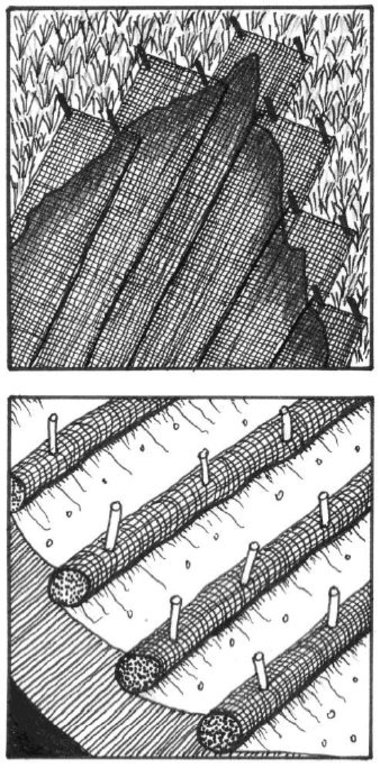Use of sediment retention fibre rolls (SRFR) and erosion blankets to stabilise slopes after fire [แอฟริกาใต้]
- ผู้สร้างสรรค์:
- การอัพเดท:
- ผู้รวบรวม: Dirk Pretorius
- ผู้เรียบเรียง: –
- ผู้ตรวจสอบ: William Critchley, Rima Mekdaschi Studer
Wood wool rolls/fibre rolls
technologies_6000 - แอฟริกาใต้
ดูส่วนย่อย
ขยายทั้งหมด ย่อทั้งหมด1. ข้อมูลทั่วไป
1.2 รายละเอียดที่ติดต่อได้ของผู้รวบรวมและองค์กรที่เกี่ยวข้องในการประเมินและการจัดเตรียมทำเอกสารของเทคโนโลยี
วิทยากรหลัก
ผู้เชี่ยวชาญ SLM:
Buckle Jacob
Hive Carbon
แอฟริกาใต้
ชื่อของโครงการซึ่งอำนวยความสะดวกในการทำเอกสารหรือการประเมินเทคโนโลยี (ถ้าเกี่ยวข้อง)
Working for Water Programme, South Africa (WfW)ชื่อขององค์กรซึ่งอำนวยความสะดวกในการทำเอกสารหรือการประเมินเทคโนโลยี (ถ้าเกี่ยวข้อง)
Department of Environmental Affairs South Africa (DEA) - แอฟริกาใต้1.3 เงื่อนไขการใช้ข้อมูลที่ได้บันทึกผ่านทาง WOCAT
ผู้รวบรวมและวิทยากรหลักยอมรับเงื่อนไขเกี่ยวกับการใช้ข้อมูลที่ถูกบันทึกผ่านทาง WOCAT:
ใช่
1.4 การเปิดเผยเรื่องความยั่งยืนของเทคโนโลยีที่ได้อธิบายไว้
เทคโนโลยีที่ได้อธิบายไว้นี้เป็นปัญหาของความเสื่อมโทรมโทรมของที่ดินหรือไม่ จึงไม่ได้รับการยอมรับว่าเป็นเทคโนโลยีเพื่อการจัดการที่ดินอย่างยั่งยืน:
ไม่ใช่
1.5 Reference to Questionnaire(s) on SLM Approaches (documented using WOCAT)
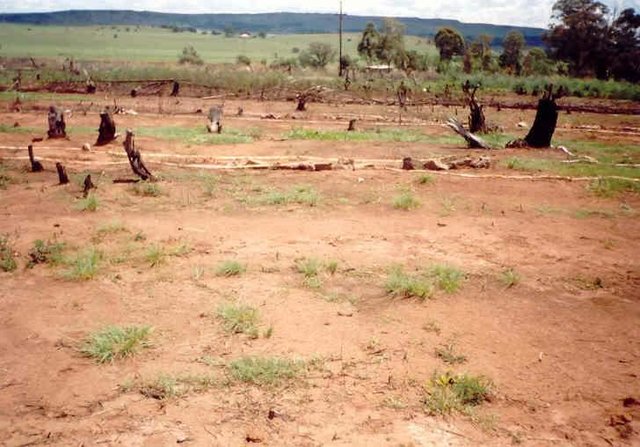
Working for Water [แอฟริกาใต้]
Government funded restoration/rehabilitation initiative as part of Working for Water project. Aim was to eradicate alien invasive.
- ผู้รวบรวม: Klaus Kellner
2. การอธิบายลักษณะของเทคโนโลยี SLM
2.1 การอธิบายแบบสั้น ๆ ของเทคโนโลยี
คำจำกัดความของเทคโนโลยี:
Sediment retention fibre rolls (SRFR) and erosion blankets were deployed to stabilise steep slopes after vegetation cover was destroyed by fire, near the town of Knysna in the Western Cape Province, South Africa
2.2 การอธิบายแบบละเอียดของเทคโนโลยี
คำอธิบาย:
Sediment retention fibre rolls (SRFR) and erosion blankets were deployed near the town of Knysna in the Western Cape Province of South Africa to stabilise slopes after vegetation was destroyed by wildfires in 2017. The predominant geology is quartzite, shale, schist, conglomerate and dune sand. The soils of this area are generally acidic and nutrient-poor occurring, on moderate to steep slopes, ranging from 5 m to 1,220 m above sea level. The area receives summer and winter rainfall with an annual average of around 650 to 700 mm. The Knysna fires were the worst wildfire disaster in South African history (more than 21 000 ha were affected – destroying more than 800 buildings, 5000 ha of forest plantations and claiming the lives of seven people). Investigations reported that its severity was caused by a cocktail of factors, including drought, low atmospheric humidity, strong warm Bergwind conditions and abundant biomass. After the fires, the lack of vegetation cover on steep sandy slopes in the affected areas posed an immediate danger of erosion and landslides to downstream catchments, ravines and man-made infrastructure. Areas with high infestations of invasive alien plants required active re-establishment of indigenous plants and the removal of alien seedlings (popular and aspen) after germination. It is estimated that 53 km of wood fibre rolls (or "sausages") and 54 000 m² of erosion blankets (Woodwool fibre filled) have been installed on post-fire erosion mitigation projects. Furthermore hydroseeding was carried out with the annual grass "teff" (Eragrostis tef) to serve as an interim (annual grass) soil stabiliser. This will be replaced by indigenous plant growth in time. The project was implemented in the following stages:
1.Identification of priority areas where infrastructure was threatened (using GIS modelling)
2.Acquisition of restoration materials – SRFR and erosion blankets produced through secondary industries created through the removal of invasive alien plants (popular and aspen)
3.Training of local community members on implementation of restoration measures
4.Removal of all burnt woody material
5.Introduction of indigenous seed
6.Installation of erosion control blankets or hydroseeding (seeding using a slurry of seed and mulch)
7.Installation of SRFR
8.As part of maintenance, removal of invasive alien vegetation seedlings
2.3 รูปภาพของเทคโนโลยี
2.5 ประเทศภูมิภาค หรือสถานที่ตั้งที่เทคโนโลยีได้นำไปใช้และได้รับการครอบคลุมโดยการประเมินนี้
ประเทศ:
แอฟริกาใต้
ภูมิภาค/รัฐ/จังหวัด:
Western Cape
ระบุการกระจายตัวของเทคโนโลยี:
- กระจายไปอย่างสม่ำเสมอในพื้นที่
If precise area is not known, indicate approximate area covered:
- 10-100 ตร.กม.
Is/are the technology site(s) located in a permanently protected area?
ไม่ใช่
Map
×2.6 วันที่การดำเนินการ
ระบุปีที่ใช้:
2018
2.7 คำแนะนำของเทคโนโลยี
ให้ระบุว่าเทคโนโลยีถูกแนะนำเข้ามาอย่างไร:
- ทางโครงการหรือจากภายนอก
3. การจัดประเภทของเทคโนโลยี SLM
3.1 วัตถุประสงค์หลักของเทคโนโลยี
- ลด ป้องกัน ฟื้นฟู การเสื่อมโทรมของที่ดิน
- อนุรักษ์ระบบนิเวศน์
- ป้องกันพื้นที่ลุ่มน้ำ/บริเวณท้ายน้ำ โดยร่วมกับเทคโนโลยีอื่นๆ
- รักษาสภาพหรือปรับปรุงความหลากหลายทางชีวภาพ
- ลดความเสี่ยงของภัยพิบัติ
3.2 ประเภทของการใช้ที่ดินในปัจจุบันที่ได้นำเทคโนโลยีไปใช้

ป่า/พื้นที่ทำไม้
- ป่ากึ่งธรรมชาติ / พื้นที่ทำไม้
(Semi-)natural forests/ woodlands: Specify management type:
- การใช้ประโยชน์จากป่า ยกเว้นไม้
Are the trees specified above deciduous or evergreen?
- evergreen
ผลิตภัณฑ์และบริการ:
- การป้องกันภัยธรรมชาติ

การตั้งถิ่นฐาน โครงสร้างพื้นฐาน
- การตั้งถิ่นฐาน ตึกอาคาร

ทางน้ำ แหล่งน้ำ พื้นที่ชุ่มน้ำ
- ทางระบายน้ำ ทางน้ำ
3.3 Has land use changed due to the implementation of the Technology?
Has land use changed due to the implementation of the Technology?
- No (Continue with question 3.4)
3.4 การใช้น้ำ
การใช้น้ำของที่ดินที่มีการใช้เทคโนโลยีอยู่:
- จากน้ำฝน
3.5 กลุ่ม SLM ที่ตรงกับเทคโนโลยีนี้
- การปรับปรุงดิน / พืชคลุมดิน
- มาตรการปลูกพืชขวางความลาดชัน (cross-slope measure)
3.6 มาตรการ SLM ที่ประกอบกันเป็นเทคโนโลยี

มาตรการอนุรักษ์ด้วยวิธีพืช
- V2: หญ้าและไม้ยืนต้น

มาตรการอนุรักษ์ด้วยโครงสร้าง
- S6: กำแพง สิ่งกีดขวาง รั้วไม้ รั้วต่างๆ
3.7 รูปแบบหลักของการเสื่อมโทรมของที่ดินที่ได้รับการแก้ไขโดยเทคโนโลยี

การกัดกร่อนของดินโดยน้ำ
- Wt (Loss of topsoil): การสูญเสียดินชั้นบนหรือการกัดกร่อนที่ผิวดิน
- Wm (Mass movement): การเคลื่อนตัวของมวลดินหรือดินถล่ม

การกัดกร่อนของดินโดยลม
- Eo (Offsite degradation effect): ผลกระทบนอกพื้นที่

การเสื่อมโทรมของน้ำ
- Hp (Decline of surface water quality): การลดลงของคุณภาพน้ำที่ผิวดิน
3.8 การป้องกัน การลดลง หรือการฟื้นฟูความเสื่อมโทรมของที่ดิน
ระบุเป้าหมายของเทคโนโลยีกับความเสื่อมโทรมของที่ดิน:
- ป้องกันความเสื่อมโทรมของที่ดิน
- ฟื้นฟูบำบัดที่ดินที่เสื่อมโทรมลงอย่างมาก
4. ข้อมูลจำเพาะด้านเทคนิค กิจกรรมการนำไปปฏิบัติใช้ ปัจจัยนำเข้า และค่าใช้จ่าย
4.1 แบบแปลนทางเทคนิคของเทคโนโลยี
ข้อมูลจำเพาะด้านเทคนิค (แบบแปลนทางเทคนิคของเทคโนโลยี):
1.Prepare the area to be restored
2.Determine the spacing of the rolls as a function of soil type and slope
3.Installation of erosion rolls (6 m long) and blankets (2.5m x 50 m) must overlap
4.Use wooden stakes to secure the rolls and blankets – rolls (50cm) – 1.2 meter apart, blankets (30cm) – 1meter appart
ผู้เขียน:
Erosion Control Technology Council
วันที่:
09/11/2021
ข้อมูลจำเพาะด้านเทคนิค (แบบแปลนทางเทคนิคของเทคโนโลยี):
1. The first step in the installation of the erosion blankets on slopes is site preparation. Be sure the site is properly prepared before installing any blankets. The site should be fine graded to a smooth profile and relatively free from all weeds, clods, stones, roots, sticks, rivulets, gullies, crusting and caking. Fill any voids and make sure that the slope is compacted properly.
2. At the top of the slope dig an anchor trench 20 cm deep by 20 cm wide. The blankets will be anchored in this trench with staples.
3. Starting at the crest of the slope, roll the blankets down the slope in a controlled manner.
4. Seed the area to be vegetated (hydroseeding).
ผู้เขียน:
Erosion Control Technology Council
วันที่:
09/11/2021
4.2 ข้อมูลทั่วไปเกี่ยวกับการคำนวณปัจจัยนำเข้าและค่าใช้จ่าย
ให้ระบุว่าค่าใช้จ่ายและปัจจัยนำเข้าได้รับการคำนวณอย่างไร:
- ต่อหน่วยเทคโนโลยี
โปรดระบุหน่วย:
ha
Specify dimensions of unit (if relevant):
1
อื่นๆ หรือสกุลเงินประจำชาติ (ระบุ):
Rand
If relevant, indicate exchange rate from USD to local currency (e.g. 1 USD = 79.9 Brazilian Real): 1 USD =:
15.0
ระบุค่าเฉลี่ยของค่าจ้างในการจ้างแรงงานต่อวัน:
R180
4.3 กิจกรรมเพื่อการจัดตั้ง
| กิจกรรม | Timing (season) | |
|---|---|---|
| 1. | Prepare area to be restored | After fires before onset of rainfall period |
| 2. | Installation of erosion rolls (6m Long) and erosion blankets (2.5 m by 50 m) - must overlap | After fires before onset of rainfall period |
| 3. | Hydroseeding | After installation of erosion rolls and blankets |
4.4 ค่าใช้จ่ายของปัจจัยนำเข้าที่จำเป็นสำหรับการจัดตั้ง
| ปัจจัยนำเข้า | หน่วย | ปริมาณ | ค่าใช้จ่ายต่อหน่วย | ค่าใช้จ่ายทั้งหมดต่อปัจจัยนำเข้า | %ของค่าใช้จ่ายที่ก่อให้เกิดขึ้นโดยผู้ใช้ที่ดิน | |
|---|---|---|---|---|---|---|
| แรงงาน | Unskilled labour (including transport) | per day | 84.0 | 260.0 | 21840.0 | |
| อุปกรณ์ | Spades, hammer, scissors, rakes, hand saw | per day | 5.0 | 20.0 | 100.0 | |
| วัสดุด้านพืช | Grass seed mix | kg | 50.0 | 100.0 | 5000.0 | |
| วัสดุสำหรับก่อสร้าง | SRFB 10m interval including stakes | per meter | 1000.0 | 50.0 | 50000.0 | |
| วัสดุสำหรับก่อสร้าง | Erosion blankets | per square meter | 10000.0 | 13.0 | 130000.0 | |
| วัสดุสำหรับก่อสร้าง | 1.0 | |||||
| อื่น ๆ | Hydro seeding (including fiber, binding medium, seed and organic fertilizer) | per ha | 1.0 | 12000.0 | 12000.0 | |
| ค่าใช้จ่ายทั้งหมดของการจัดตั้งเทคโนโลยี | 218940.0 | |||||
| Total costs for establishment of the Technology in USD | 14596.0 | |||||
ถ้าผู้ใช้ที่ดินรับภาระน้อยกว่า 100% ของค่าใช้จ่าย ให้ระบุว่าใครเป็นผู้รับผิดชอบส่วนที่เหลือ:
Government
4.5 การบำรุงรักษาสภาพหรือกิจกรรมที่เกิดขึ้นเป็นประจำ
| กิจกรรม | ช่วงระยะเวลา/ความถี่ | |
|---|---|---|
| 1. | After floods the site must be inspected and restored if necessary | After floods |
| 2. | Remove invasive alien vegetation seedlings | After germination (during first 6 months) |
4.6 ค่าใช้จ่ายของปัจจัยนำเข้าและกิจกรรมที่เกิดขึ้นเป็นประจำที่ต้องการการบำรุงรักษา (ต่อปี)
| ปัจจัยนำเข้า | หน่วย | ปริมาณ | ค่าใช้จ่ายต่อหน่วย | ค่าใช้จ่ายทั้งหมดต่อปัจจัยนำเข้า | %ของค่าใช้จ่ายที่ก่อให้เกิดขึ้นโดยผู้ใช้ที่ดิน | |
|---|---|---|---|---|---|---|
| แรงงาน | Restoration of site after flooding events | per day | 24.0 | 260.0 | 6240.0 | |
| อุปกรณ์ | Tools to do restoration (same as installation) | per day | 3.0 | 30.0 | 90.0 | |
| วัสดุด้านพืช | Removal of invasive alien vegetation | per day | 24.0 | 60.0 | 1440.0 | |
| วัสดุสำหรับก่อสร้าง | SRFR | per meter | 50.0 | 50.0 | 2500.0 | |
| วัสดุสำหรับก่อสร้าง | Erosion blankets (only pegs) | per square meter | 300.0 | 3.0 | 900.0 | |
| ค่าใช้จ่ายทั้งหมดของการบำรุงรักษาสภาพเทคโนโลยี | 11170.0 | |||||
| Total costs for maintenance of the Technology in USD | 744.67 | |||||
4.7 ปัจจัยสำคัญที่สุดที่มีผลกระทบต่อค่าใช้จ่าย
ปัจจัยสำคัญที่สุดที่มีผลกระทบต่อค่าใช้จ่ายต่างๆ:
Labour availability, availability of material, transport cost
5. สิ่งแวดล้อมทางธรรมชาติและของมนุษย์
5.1 ภูมิอากาศ
ฝนประจำปี
- < 250 ม.ม.
- 251-500 ม.ม.
- 501-750 ม.ม.
- 751-1,000 ม.ม.
- 1,001-1,500 ม.ม.
- 1,501-2,000 ม.ม.
- 2,001-3,000 ม.ม.
- 3,001-4,000 ม.ม.
- > 4,000 ม.ม.
เขตภูมิอากาศเกษตร
- กึ่งแห้งแล้ง
5.2 สภาพภูมิประเทศ
ค่าเฉลี่ยความลาดชัน:
- ราบเรียบ (0-2%)
- ลาดที่ไม่ชัน (3-5%)
- ปานกลาง (6-10%)
- เป็นลูกคลื่น (11-15%)
- เป็นเนิน (16-30%)
- ชัน (31-60%)
- ชันมาก (>60%)
ธรณีสัณฐาน:
- ที่ราบสูง/ที่ราบ
- สันเขา
- ไหล่เขา
- ไหล่เนินเขา
- ตีนเนิน
- หุบเขา
ระดับความสูง:
- 0-100 เมตร
- 101-500 เมตร
- 501-1,000 เมตร
- 1,001-1,500 เมตร
- 1,501-2,000 เมตร
- 2,001-2,500 เมตร
- 2,501-3,000 เมตร
- 3,001-4,000 เมตร
- > 4,000 เมตร
ให้ระบุถ้าเทคโนโลยีได้ถูกนำไปใช้:
- ไม่เกี่ยวข้อง
5.3 ดิน
ค่าเฉลี่ยความลึกของดิน:
- ตื้นมาก (0-20 ซ.ม.)
- ตื้น (21-50 ซ.ม.)
- ลึกปานกลาง (51-80 ซ.ม.)
- ลึก (81-120 ซ.ม.)
- ลึกมาก (>120 ซ.ม.)
เนื้อดิน (ดินชั้นบน):
- หยาบ/เบา (ดินทราย)
เนื้อดินล่าง (> 20 ซ.ม.ต่ำจากผิวดิน):
- ปานกลาง (ดินร่วน ทรายแป้ง)
5.4 ความเป็นประโยชน์และคุณภาพของน้ำ
ระดับน้ำใต้ดิน:
<5 เมตร
น้ำไหลบ่าที่ผิวดิน:
ปานกลาง
คุณภาพน้ำ (ที่ยังไม่ได้บำบัด):
เป็นน้ำเพื่อการดื่มที่ไม่ดี (จำเป็นต้องได้รับการบำบัด)
Water quality refers to:
surface water
ความเค็มของน้ำเป็นปัญหาหรือไม่:
ไม่ใช่
กำลังเกิดน้ำท่วมในพื้นที่หรือไม่:
ไม่ใช่
5.5 ความหลากหลายทางชีวภาพ
ความหลากหลายทางชนิดพันธุ์:
- สูง
ความหลากหลายของแหล่งที่อยู่:
- ต่ำ
5.6 ลักษณะของผู้ใช้ที่ดินที่นำเทคโนโลยีไปปฏิบัติใช้
อยู่กับที่หรือเร่ร่อน:
- อยู่กับที่
แนวทางการตลาดของระบบการผลิต:
- ทำการค้า/การตลาด
รายได้ที่มาจากนอกฟาร์ม:
- > 50% ของรายได้ทั้งหมด
ระดับของความมั่งคั่งโดยเปรียบเทียบ:
- รวย
อายุของผู้ใช้ที่ดิน:
- วัยกลางคน
5.7 Average area of land used by land users applying the Technology
- < 0.5 เฮกตาร์
- 0.5-1 เฮกตาร์
- 1-2 เฮกตาร์
- 2-5 เฮกตาร์
- 5-15 เฮกตาร์
- 15-50 เฮกตาร์
- 50-100 เฮกตาร์
- 100-500 เฮกตาร์
- 500-1,000 เฮกตาร์
- 1,000-10,000 เฮกตาร์
- >10,000 เฮกตาร์
5.8 กรรมสิทธิ์ในที่ดิน สิทธิในการใช้ที่ดินและสิทธิในการใช้น้ำ
กรรมสิทธิ์ในที่ดิน:
- รัฐ
- municipality owned
- municipality
Are land use rights based on a traditional legal system?
ไม่ใช่
5.9 การเข้าถึงบริการและโครงสร้างพื้นฐาน
สุขภาพ:
- จน
- ปานกลาง
- ดี
การศึกษา:
- จน
- ปานกลาง
- ดี
ความช่วยเหลือทางด้านเทคนิค:
- จน
- ปานกลาง
- ดี
การจ้างงาน (เช่น ภายนอกฟาร์ม):
- จน
- ปานกลาง
- ดี
ตลาด:
- จน
- ปานกลาง
- ดี
พลังงาน:
- จน
- ปานกลาง
- ดี
ถนนและการขนส่ง:
- จน
- ปานกลาง
- ดี
น้ำดื่มและการสุขาภิบาล:
- จน
- ปานกลาง
- ดี
บริการด้านการเงิน:
- จน
- ปานกลาง
- ดี
6. ผลกระทบและสรุปคำบอกกล่าว
6.1 ผลกระทบในพื้นที่ดำเนินการ (On-site) จากการใช้เทคโนโลยี
ผลกระทบทางด้านเศรษฐกิจและสังคม
รายได้และค่าใช้จ่าย
ความหลากหลายของแหล่งผลิตรายได้
แสดงความคิดเห็น/ระบุ:
Restoration resulted in job creation for local communities
ผลกระทบด้านสังคมวัฒนธรรมอื่น ๆ
โอกาสทางด้านสันทนาการ
แสดงความคิดเห็น/ระบุ:
Improved ecotourism - land restored to natural state - hiking and cycling
Value of land for development
แสดงความคิดเห็น/ระบุ:
Land without degradation more valuable for development
ผลกระทบด้านนิเวศวิทยา
วัฐจักรน้ำหรือน้ำบ่า
น้ำไหลบ่าที่ผิวดิน
แสดงความคิดเห็น/ระบุ:
The introduction of structures and increased vegetation cover resulted in reduced runoff
การระบายน้ำส่วนเกิน
แสดงความคิดเห็น/ระบุ:
The introduced technologies also improved excess water drainage and less flooding
ดิน
สิ่งปกคลุมดิน
แสดงความคิดเห็น/ระบุ:
Vegetation cover improved with the introduction of hydroseeding and retention of topsoil containing indigenous seed
การสูญเสียดิน
แสดงความคิดเห็น/ระบุ:
Soil loss was reduced due to the introduction of the SRFR and improved vegetation cover
ความหลากหลายทางชีวภาพของพืชและสัตว์
การปกคลุมด้วยพืช
แสดงความคิดเห็น/ระบุ:
Vegetation cover improved due to the soil stabilisation and introduction of hydroseeding (annual grass protected soil until natural vegetation established)
มวลชีวภาพ/เหนือดินชั้น C
แสดงความคิดเห็น/ระบุ:
Improved biomass due to the improved vegetation cover and reduction of soil loss (topsoil with high C content)
พืชพันธุ์ต่างถิ่นที่รุกล้ำเข้ามา
แสดงความคิดเห็น/ระบุ:
Maintenance of the applied technology included the removal of alien species
ความหลากหลายของสัตว์
แสดงความคิดเห็น/ระบุ:
The technology resulted in the reestablishment of the natural vegetation and improved biodiversity
ลดความเสี่ยงของภัยพิบัติ
ผลกระทบจากน้ำท่วม
แสดงความคิดเห็น/ระบุ:
One of the main reasons for the introduction of this innovative technology is the reduction in flood impacts due to the inclusion of structures as well as improved vegetation cover
ดินถล่ม/ ซากต่าง ๆ ที่ถูกพัดพามา
แสดงความคิดเห็น/ระบุ:
The added benefit of the technology is the reduction in the risk of landslides due to the inclusion of soil stabilising structures and improved vegetation cover
6.2 ผลกระทบนอกพื้นที่ดำเนินการ (Off-site) จากการใช้เทคโนโลยี
น้ำท่วมพื้นที่ท้ายน้ำ
แสดงความคิดเห็น/ระบุ:
The introduction of the technology resulted in improved drainage and therefore less downstream flooding
การทับถมของดินตะกอนพื้นที่ท้ายน้ำ
แสดงความคิดเห็น/ระบุ:
The introduction of sediment trapping structures as well as improved vegetation cover resulted in less downstream siltation
ความเสียหายต่อโครงสร้างพื้นฐานของรัฐหรือของเอกชน
แสดงความคิดเห็น/ระบุ:
The risk of damage to infrastructure was reduced due to the decrease in risk of flooding and landslides
6.3 การเผชิญและความตอบสนองของเทคโนโลยีต่อการเปลี่ยนแปลงสภาพภูมิอากาศที่ค่อยเป็นค่อยไป และสภาพรุนแรงของภูมิอากาศ / ภัยพิบัติ (ที่รับรู้ได้โดยผู้ใช้ที่ดิน)
สภาพรุนแรงของภูมิอากาศ (ภัยพิบัติ)
ภัยพิบัติทางอุตุนิยมวิทยา
| เทคโนโลยีมีวิธีการรับมืออย่างไร | |
|---|---|
| พายุฝนประจำท้องถิ่น | ปานกลาง |
ภัยพิบัติจากสภาพภูมิอากาศ
| เทคโนโลยีมีวิธีการรับมืออย่างไร | |
|---|---|
| ไฟป่า | ไม่ดี |
6.4 การวิเคราะห์ค่าใช้จ่ายและผลประโยชน์ที่ได้รับ
ผลประโยชน์ที่ได้รับเปรียบเทียบกับค่าใช้จ่ายในการจัดตั้งเป็นอย่างไร (จากมุมมองของผู้ใช้ที่ดิน)
ผลตอบแทนระยะสั้น:
ด้านบวก
ผลตอบแทนระยะยาว:
ด้านบวก
ผลประโยชน์ที่ได้รับเปรียบเทียบกับค่าใช้จ่ายในการบำรุงรักษาหรือต้นทุนที่เกิดขึ้นซ้ำอีก เป็นอย่างไร (จากมุมมองของผู้ใช้ที่ดิน)
ผลตอบแทนระยะสั้น:
ด้านบวก
ผลตอบแทนระยะยาว:
ด้านบวก
6.5 การปรับตัวของเทคโนโลยี
- ครั้งเดียวหรือเป็นการทดลอง
6.6 การปรับตัว
เทคโนโลยีได้รับการปรับเปลี่ยนเมื่อเร็วๆนี้ เพื่อให้ปรับตัวเข้ากับสภาพที่กำลังเปลี่ยนแปลงหรือไม่:
ไม่ใช่
6.7 จุดแข็ง / ข้อได้เปรียบ / โอกาสของเทคโนโลยี
| จุดแข็ง / ข้อได้เปรียบ / โอกาสในทัศนคติของผู้ใช้ที่ดิน |
|---|
| Very important technology to stabilise degraded landscapes |
| Technology helps to improve the habitat - biodiversity in the protected area |
| Technology helps to prevent landslides and down-stream siltation |
| จุดแข็ง / ข้อได้เปรียบ / โอกาสในทัศนคติของผู้รวบรวมหรือวิทยากรหลัก |
|---|
| Although fairly expensive to implement the technology helped to restore high value land in the Knysna area |
6.8 จุดอ่อน / ข้อเสียเปรียบ / ความเสี่ยงของเทคโนโลยีและวิธีการแก้ไข
| จุดอ่อน / ข้อเสียเปรียบ / ความเสี่ยงในทัศนคติของผู้ใช้ที่ดิน | มีวิธีการแก้ไขได้อย่างไร |
|---|---|
| Sensitive to fire | Construct fire breaks around areas of intervention |
| Sensitive to flooding | Better timing of intervention (avoid high rainfall periods) |
7. การอ้างอิงและการเชื่อมต่อ
7.1 วิธีการและแหล่งข้อมูล
- ไปเยี่ยมชมภาคสนาม การสำรวจพื้นที่ภาคสนาม
- การสัมภาษณ์ผู้เชี่ยวชาญด้าน SLM หรือผู้ชำนาญ
1
- การเก็บรวบรวมมาจากรายงานและเอกสารที่มีอยู่
1
วันที่เก็บรวบรวมข้อมูล(ภาคสนาม) :
27/09/2021
7.2 การอ้างอิงถึงสิ่งตีพิมพ์
หัวข้อ, ผู้เขียน, ปี, หมายเลข ISBN:
Title, author, year, ISBN Caring for Natural Rangelands, Ken Coetzee, 978-1-86914-071-7
ชื่อเรื่อง ผู้เขียน ปี ISBN:
https://www.loot.co.za/product/ken-coetzee-caring-for-natural-rangelands/stkr-450-g690
7.3 Links to relevant online information
ชื่อเรื่องหรือคำอธิบาย:
KNYSNA FIRES: HOW SOON WE FORGET
URL:
https://www.scli.org.za/knysna-fires-soon-forget
ชื่อเรื่องหรือคำอธิบาย:
Sediment retention fiber rolls – general usage and installation guidelines April 2011
URL:
https://www.ectc.org
ลิงก์และโมดูล
ขยายทั้งหมด ย่อทั้งหมดลิงก์

Working for Water [แอฟริกาใต้]
Government funded restoration/rehabilitation initiative as part of Working for Water project. Aim was to eradicate alien invasive.
- ผู้รวบรวม: Klaus Kellner
โมดูล
ไม่มีโมดูล


